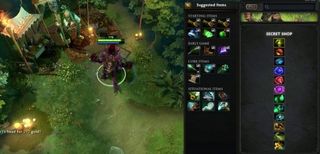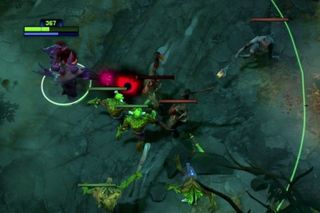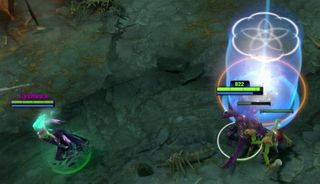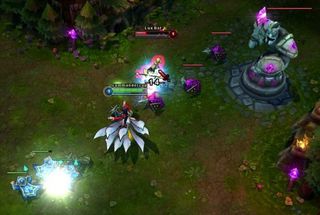Map Layout
Dota 2 and League of Legends have maps with the same basic layouts. Each has a top, middle and bottom lane with 3 layers of turrets in each lane. In between the lanes is the Jungle, which is filled with creep camps that can be killed as an alternate source of gold and experience.
Summoner's Rift is considerably smaller than Dota 2's unnamed map. Two of the main attractions are Baron Nashor and Dragon, massive neutral monsters that provide global gold for the team that kills them. The big monsters are also joined by the Lizard Elder and Ancient Golem who provide buffs when defeated. A dedicated jungler is essential to maintaining control of these buffs as well as the objectives on the map because of Smite—a Summoner Spell that deals massive true damage to monsters.
Runes, Roshan and the abundance of shops are unique to Dota 2. Roshan is Dota 2's version of Baron Nashor and drops the Aegis of the Immortal which will revive the hero holding it with full health and mana upon death. Runes periodically spawn on two designated locations outlined below and can be immediately used or stored in a Bottle. These runes range from a speed boost to double damage for a short time. Another distinction between the two maps is the fact that each side of the Dota 2 map has three shops: a main shop, side shop and a secret shop.

Metagame
This is where things radically change between the two games. Broadly, Dota 2 and League of Legends are similar. You spend time in a lane farming to prepare for late game team fights. Win a few fights, get a big enough lead and you can end the game by destroying the other team's main base building—the Nexus in LoL and the Ancient in Dota 2.
Then what's the biggest difference between Dota 2 and League? No, it's not the skill required to play, it's actually the feel of the two games. Moving between the two can be awkward even for seasoned players because of the mechanical differences—turning speed, attack and casting animations.
The biggest gaming news, reviews and hardware deals
Keep up to date with the most important stories and the best deals, as picked by the PC Gamer team.
One of the most jarring differences is the basic movement and attacks in Dota 2. To put it bluntly: commands—attacking, moving, casting a spell, and so on—happen more quickly in LoL. Dota 2's longer attacking and casting animations means that to the uninitiated, Dota 2 can feel sluggish.

The usual setup for a game of League is to have a tanky champion in top lane, an AP carry in mid lane, a support and AD carry in bot lane and a jungler to pick up the neutral monsters in the Jungle. Although pro teams mix it up by swapping the physical lane positions, the metagame of League of Legends is fairly rigid.
Dota 2's metagame has a similar, but distinct history that is filled with major changes to the way that lanes work. The current metagame differs between the pros and casual players. Most games have two players in bottom lane, two players in top lane and a player in the middle lane. This can also be swapped to have 1 top, 2 bot, a jungler and a mid or even three bottom, one top and one mid.
The lack of a recall spell and the importance of the Town Portal Scroll in Dota 2 is another huge reason for the differences in strategy. Battles can happen in the blink of an eye in Dota simply because players can move around the map more quickly with Town Portal Scrolls. But in League of Legends, crossing the map in either direction can be a 1- or 2-minute commute. Because the 300-second cooldown Teleport Summoner Spell is the only tool available to you in LoL for warping, team compositions and strategies can be focused almost entirely on split pushing. Both games have slightly varied focuses on what strategies do and don't work.

It's obvious why Dota has garnered a reputation as a hardcore game. High ground, creep denial (you can attack your own minions when they're below 50% HP), and the possibility of getting instagibbed when you walk just a touch too far from your tower are nuances that aren't present in League. On the other hand, LoL does have a brush system which renders players invisible to anyone outside of the brush. Plus, being able to Recall to base at any time with a channeling spell changes things too. It may take a while to get back to the lane, but your trip to base should only take a few seconds.
Items
There is a ridiculous assortment of items available to players of both games. Building your hero or champion correctly is a huge part of the MOBA experience.
The types of items available differs slightly between both games. One of the many small differences between the two systems is the presence of item recipes in Dota 2. Buying a recipe while having the necessary items in your inventory will upgrade your pile of junk into a brand new sword—or whatever item the recipe creates. In League of Legends, you purchase the actual upgraded item after collecting all of the prerequisites.
We've already mentioned that Dota 2 lacks any items that increase the pain-inflicting potential of hero abilities, but we haven't talked about items like the Blink Dagger, Aghanim's Scepter and the Scythe of Vyse. Dota 2 is filled with items that have abilities that require activation. Clicking on your Blink Dagger and then clicking on the screen will teleport you a short distance on a fairly short cooldown. Using the Scythe of Vyse on any of your enemies turns them into a helpless little pig. Items like these are essential to the dynamic of Dota 2 because they expand what characters are able to do. It's not uncommon for players to have three or four items that can be activated in their inventory by the end of the game. In fact, many of these active abilities have surfaced in LoL as summoner spells and champion abilities—Flash and Lulu's Whimsy are just two examples.

League of Legends doesn't have as many crucial active items, but many champions do end up buying items like the Locket of the Iron Solari which shields allies within a small radius upon activation.
Both games have a wide variety of items that have passive abilities as well as abilities that trigger when your character is hit. Buying a Ruby Crystal in League of Legends will give you +180 health whereas a Sapphire Crystal will give you +200 mana. A Last Whisper will make all of your attacks ignore 35% of your target's armor.
Getting the right items can be as simple as selecting from the pool of recommended items or looking up what the pros are building in their games.
Next page: We take a look at how Riot and Valve have been supporting Dota 2 and LoL through monetization, patches and eSports.
Most Popular






